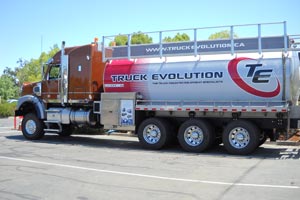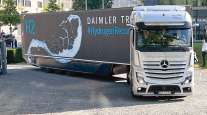Daimler Says Investments During Recession Resulting in Higher Vocational-Market Sales

This story appears in the Aug. 4 print edition of Transport Topics.
YOUNTVILLE, Calif. — Daimler Trucks North America said it’s reaping returns in sales of heavy- and medium-duty vocational trucks based on investments that started during the depths of the recession.
In a July 29 press event here, DTNA executives said sales of Freightliner SD and M2 vocational vehicles have grown more rapidly from 2009 to 2013 than industrywide vocational sales in the United States and Canada. They said the pattern has continued during the first half of this year.
“We made a permanent, ongoing investment in the vocational truck market, starting with the launch of the SD [severe duty] family of trucks and continuing with dedicated resources, processes, products and market strategies for vocational customers and [truck equipment manufacturers],” said David Hames, a DTNA general manager.
“This is not a program du jour but a permanent structural change in our business,” he added.
The original equipment manufacturer used registration data from the Polk division of IHS Automotive and sales figures from WardsAuto.com for analysis. DTNA found that annual vocational Class 8 registrations leapt by 151% for Freightliner Trucks from 2009 to 2013, whereas industrywide, heavy-duty vocational growth was 63% over the same time.
For all Freightliner heavy-duty trucks, U.S. and Canadian retail sales grew by 161% over the same period. Industrywide Class 8 growth was 96%, according to Ward’s.
Hames said that characterizing vocational vehicles as dump trucks and concrete mixers is a significant oversimplification. He said the company slices the market into six segments: specialized hauling, vehicles for utility companies, food-and-beverage distribution, government fleets (mainly states and municipalities), construction and refuse.
Vocational sales suffered disproportionately during the recession because of the collapse in buying in the construction and government segments.
In its vocational business, Freightliner does not sell directly to end users but rather to truck equipment manufacturers that include a truck cab, engine and chassis as part of a larger machine.
As an example, Richard Saward, another DTNA general manager, said his vocational division supplies $130,000 chassis to TEMs who use them to produce crane trucks or other vocational vehicles that might sell for $400,000.
Freightliner’s vocational platform is the SD series, mainly 114SD and 122SD, where the number is the bumper-to-back-of-cab measurement in inches. The company used to call this its Coronado series.
On the heavier end of medium duty, Freightliner uses its M2 line for vocational applications, some of which can creep into the lighter end of Class 8, sometimes called “Baby 8s.”
Saward and Hames were candid in their assessments of the market, saying Navistar’s International trucks led in most of the six vocational segments through 2009, with the Kenworth and Peterbilt lines of Paccar Inc. dominating in heavy haul. Freightliner was generally No. 2 behind them but was not willing to stay there, Saward said.
DTNA usually defines its market as Classes 6-8 vehicles in North America. Within that grouping, all OEMs sold 44,310 vocational vehicles in 2013, up from 28,443 in 2009. Sales for all Classes 6-8 trucks on the continent topped 339,000 units last year, meaning vocational was about 13% of last year’s total.
As part of the event, Freightliner announced it will add the Cummins Westport ISX12 G natural-gas engine as an option for its 114SD truck starting next year. The company has offered the ISL G as an option for 114SD, but ISL G has only 9 liters of displacement as a nat-gas power plant.
The SD vocationals are also big users of DTNA’s Detroit DD16 engines. At the event, the company displayed two tractors with 16-liter power plants, one for heavy haul that has a gross vehicle weight rating of 210,000 pounds, and another for oil field services that delivers power to four axles, including the drive axle.
Richard Howard, DTNA’s senior vice president for sales and marketing since April, said investing near the bottom of the economic trough made sense.
“The overall truck market is growing, yes, but we want to penetrate this sector [vocational] like never before. We’ve always had a desire to grow [in vocational] and compete there, and there was no better time to start than when we did,” Howard said, adding that the company would be trying to gain market share as the total market increased.
Howard said the company has added engineers, marketing and sales staff to the vocational side to help growth.
As for sales in general, Howard said heavy-duty sales are running 10% ahead of their 2013 pace in the first half and expects that growth to continue through at least the end of this year.




